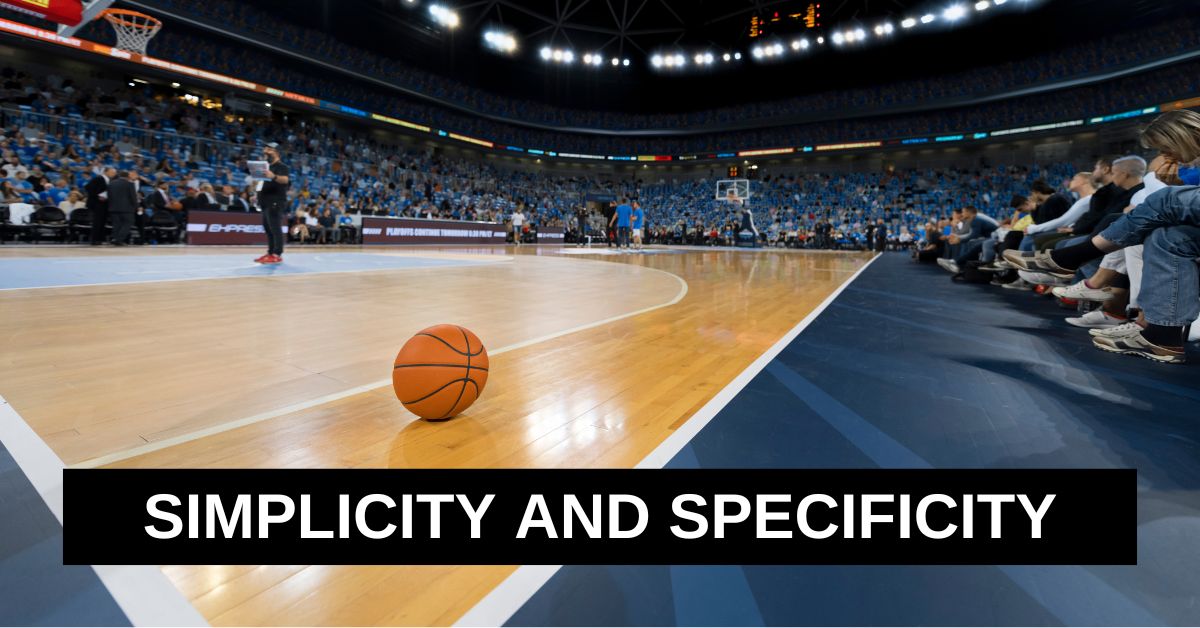|
Basketball is a game with a lot of variables. You have the offensive end of the floor which includes player movement, ball movement, spacing, screening, cutting, attacking gaps, angles, and then there's shot selection. Most often, teams are built and designed around a specific system of play, and that system of play integrates all of the aforementioned elements. On the defensive side of the ball, you have ball pressure, defensive positioning, help defense, whether you're playing in the gaps, denying passing lanes, forcing baseline, forcing middle, trapping, playing a zone. Your defensive system will dictate which of these core elements you'll be utilizing in your scheme. Then, there is the hidden and unknown elements within the transition. Whether you're transitioning to the defensive end of the floor, or getting a stop and transitioning to the offensive end of the floor. All of these specific elements have variables that can either help or harm your success within the game. Success, defined as wins and losses in this particular context. Offense Wins GamesI'm sure you have heard the old adage, "offense wins games, defense wins championships." I'm a firm believe that offense wins championships, but I'm also an offensive minded coach. A quote I do firmly believe in is, "Defense travels well", and an indication that any given night you're able to play great defense, whereas you're likely going to have an off night shooting the ball, and/or getting to your spots on the floor for great offense. Double Post Offense The double post offense brings a lot elements of ball control, paint control, and high percentage shots. The challenge with this type of system is that you have to spend a great deal of time on passing, footwork, screening, cutting, those wonderful post entries, and scoring in the post with your back to the basket. Let's start with spacing. You have three guards evenly spaced on the floor for purposes of shortening the pass, but also giving the offense an opportunity to enter the ball into the post. The first challenge is getting the ball into the post. Post entries, no matter the level, always seem like a challenge. You have to spend a great deal of time teaching your athletes to enter the ball into the post with either the left hand or right now. That's just the beginning. The second challenge is teaching your athletes to score in the post with their back to the basket. While this is a shot that is within 5 feet from the basket, most athletes struggle to score against defense from this range. While teams have been successful with this system, it has a lot of variables that need to be drilled and practiced. The segmentation of post players and guards is common, as the guards work on one end of the floor, and posts work on the other end of the floor. Then, they come together to work on team offense. Single Post Offense The single post offense can come in various forms. The Dribble Drive Motion is the most popular and has been seen on the NCAA March Madness stage with the likes of Kentucky, Alabama, and most recently Greg Kampe's Oakland team that upset Kentucky. There are hundreds of teams that run the DDM (Dribble Drive Motion). Another variation is the strong side post, whereas the post player that has the greatest amount of success on either the right or left side will only post up on that side, the opposite side is available for backside cutting, driving, or the 2-man game between guards. This particular set up allows for greater space, making it more challenging to close out on shooters, and stay in front of quicker guards, meanwhile the post players is set up for offensive rebounds, and isolated on the post in post-up situations. Another variation is the ball screen continuity, popularized by Gonzaga whereas swinging the ball to the opposite side of the floor creates an immediate ball screen action to the center of the floor. The first challenge with a Dribble Drive Motion is that you need athletes that can both (1) Dribble, and (2) Drive. In some skill deficient programs, this becomes a challenge as the athletes struggle with attacking gaps, or splitting defenders. Another challenge that is still present is the necessity to enter the ball into the post, and an athlete with the ability to score with their back to the basket. Again, multiple teams have seen great success with this. Another Wisconsin favorite is the Swing Offense, whereas all players are interchangeable, and move through the continuity motion with a single post, but thrive on the Swing cut and pin down combo action. The segmentation of post players and guards is common, as the guards work on one end of the floor, and posts work on the other end of the floor. Then, they come together to work on team offense. No Post Offense I, on the other hand, am a big believer in position-less basketball whereas all athletes are interchangeable in any situation in any spot on the floor. This allows for all athletes to do the same drills. The No Post Offense, also known as the 5-Out System, has becoming increasingly popular as coaches are seeing the value of emptying the post, and forcing the defense to extend to the 3-point line, thus leaving the paint open for driving lanes, cutting, and utilizing duck-ins. Whether you have a 5'8 or 6'8, you're now putting all players into a system that enables them to utilize their skills and talents to take advantage of various situations. Teams will be more inclined to switch in against a position-less system, but this is where you get mismatches for duck-ins and quick post-ups. Position-less basketball also give everyone on the floor the opportunity for the same shots. Everyone shoots, everyone drives, everyone cuts, everyone passes, and everyone scores. Another advantage of a 5-out system is that rebounding becomes increasing difficult for the defense, as the defense is extended out to the 3-point line. When teams struggle to defense a 5-out system, they move into a zone defense. Defense Wins ChampionshipsThere are multiple defenses we can discuss, but I'll keep it simple, as the title implies. No Middle Defense This defense forces teams to operate on one side of the floor, forcing players to the baseline and denying passes or dribble action to the middle of the floor. This is a high pressure defense that is usually accompanied by a roster heavy on athletic players with quick feet and good length. The no middle defense is a great option for teams that want to throw off a team's ability to run a motion offense. It requires a high level of intensity, pressuring the ball, clogging passing, lanes, and athletes that can defend the ball one-on-one with little to no help. Pack Line Defense This is completely opposite of the No Middle Defense, as you now allow players to go to the middle. The Pack Line popularized by Dick Bennett and more recently used by Bo Ryan at Wisconsin, and today you can see it ran by the Virginia Caveliers with Tony Bennett. The defense is designed to pack the paint, choke off any post entries, doubles the post players, and forces long range shots. Lock Left Defense This defense has becoming increasingly popular due to the success of Carleton University out of Ottawa, Canada for it's tenacious defense that has given Top 10 teams fits over the years. Carleton University has won 15 out of the last 18 national championships, and praise the Lock Left Defense for their success. In the Lock Left Defense, you apply man-to-man principles. The premise is that you force every offensive player with the ball to their left. A couple of things happen in this defense.
Zone Defenses We can cover every zone defense known to man, but we'll simply cover the premise behind a zone defense. In a standard 2-3 Zone Defense, the top two guards are assigned the role of pressuring the ball, and getting tips on passes. The bottom 3 are extended the width of the court to cover corners, and have a dedicated basket protector. A really good 2-3 zone can apply a great deal of pressure, force a lot of bad shots, and keep your rim protector from extending themselves to the perimeter where they may not be quick enough to defense or recover. A 1-3-1 is another zone defense that is designed to pressure the ball on the perimeter at all potential spacing locations. lob passes are encouraged, allowing time for the defense to close out or recover, driving lanes are clogged with the X5 in the middle of the zone. The X4 is the baseline running, covering corner to corner, and the top 3 are pressuring the ball in designated areas. A 1-2-2 is another zone defense that gives teams fits, by allowing guards to extend near the volleyball line to reduce the ability to swing the ball. This keeps the defense from working extra on rotations, and keeps the ball to one side of the floor. The 2-1-2 is another great zone defense that provides coverage to the corners, help in the middle and pressure on the ball at the top of the zone. Simplicity and SpecificityWhichever strategy you select, the goal should be to find simplicity and specificity. Rising Stars Basketball focuses on fast paced position-less basketball with high pressure defense. The goal is to speed up the game, and force all players on the court ot play at an uncomfortable pace. Simplicity and Specificity is the name of the game, and athletes are allowed ultimate freedom to operate within the system of play using the skills they have developed. Successes and ExamplesThe Winter Warriors Boys Basketball team in the 2022-2023 and 2023-2024 seasons have led the state of Wisconsin in scoring among all Division 5 schools. 70.8 ppg in 2022-2023, and 80.2 ppg in 2023-2024 simply by boiling down the playbook to a simple motion offense, and simple zone press that fell back into a man-to-man defense. The athletes apply a pressure defense designed to speed up the opponent into taking quick shots, then getting out into their fast break. 60.8% of the points scored in 2023-2024 were on the break, and 14.1% were scored in the half court, while 15.1% were scored from the FT line. The majority of shots were taken within the first 8 seconds of the possession. The Winter Warriors won the Conference Championship, and Regional Championship.
The Hayward 8th Grade Boys Basketball team in the 2023-2024 season made it all the way to the state tornament and finished 3-3 with a simple motion offense, one inbounds play, and the Packline defense. The boys scored the most points in the state tournament with 83, and most of the points came on the break by pushing the ball ahead on every possession. The goal is to make everything as simple as possible, give the athletes freedom to operate, and ask the players to simply react to the situation and not overthink anything. Of course, this all starts in practice. Every single practice is fast-paced and designed to allow players to operate in chaotic situations by simply reacting.
0 Comments
Leave a Reply. |
Categories
All
|
Areas ServedHayward Wisconsin
Lac Courte Oreilles Winter Wisconsin Bruce Wisconsin Hurley Wisconsin Birchwood Wisconsin Bayfield Wisconsin Ashland Wisconsin |
Rising Stars BasketballWisconsin AAU Basketball
Crossover Crew 3v3 Basketball League Skills Camps Tips & Articles Workouts & Drills Podcast |
Contact Us |
Rising Stars Basketball Club | 10767 Nyman Ave, Hayward Wisconsin | www.Rising-Stars.us | Powered by Superior Marketing


 RSS Feed
RSS Feed